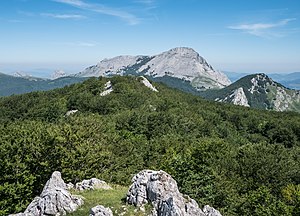This article has multiple issues. Please help improve it or discuss these issues on the talk page. (Learn how and when to remove these messages)
|

Mari, also called Mari Urraca, Anbotoko Mari ("the Lady of Anboto"), and Murumendiko Dama ("Lady of Murumendi"), is the main goddess of the ancient Basque mythology, who is said to mainly live on the eastern slope of Mount Anboto (1,330 metres). From there she takes care of the environment and dispenses justice. When clouds appear around Anboto it is said the this is because Mari has returned to her home on this mountain, the so-called "Cave of The Lady". She is married to the god Sugaar (also known as Sugoi or Maju).
Legends connect her to the weather: when she and Maju travel together hail will fall, her departures from her cave will be accompanied by storms or droughts, and which cave she lives in at different times will determine dry or wet weather: wet when she is in Anboto; dry when she is elsewhere (the details vary). Other places where she is said to dwell include the chasm of Murumendi, the cave of Gurutzegorri (Ataun), Aizkorri, and Aralar, although it is not always possible to be certain which Basque legends should be considered for her origin.
Etymology

It is believed that Mari is a modification of "Emari" (gift) or, "Amari" (mother + the suffix of profession) by losing the first vowel. The closeness in names between Mari and Mary may have helped pagans adapt their worship of Mari and undertake Christian veneration of the Virgin Mary, (Basque: Andre Maria, Biscayan: Andra Mari).
The first known written citation of the "Dame of Amboto" was made by Charles V's chronicler Esteban de Garibay Zamalloa in his Memorial histórico español.
Myths associated with Mari
Mari is the main character of Basque mythology, having the nature of a deity, unlike other creatures who share the same spiritual environment. Mari is often represented as a woman dressed in red. She is also seen as a woman of fire, a woman-tree, and as a thunderbolt. Mari is associated with various forces of nature, including thunder and wind. Additionally, she is identified with red animals (cow, ram, horse), and with the black he-goat.
Mari lives underground, normally in a cave in a high mountain, where she and her consort Sugaar meet every Friday (the night of the Akelarre or witch-meeting) to conceive the storms that will bring fertility, or sometimes disaster, to the land and the people. Mari is served by a court of sorginak (witches), and is said to feed "on the negation and affirmation" (that is, on falsehood).
Christianization
The most accepted syncretism of Mari is with the Virgin Mary; she is widely venerated by modern Catholic Basques. However, Santa Marina of Aguas Santas, a saint revered in the Basque Country, is considered a christianised version of Mari. Basque women invoke Santa Marina for protection against curses and aid in childbirth.
See also
References
- Urkiola Nature Reserve, Basque Country: the abode of the goddess Mari
- This interpretation is derived from articles in the Enciclopedia General Ilustrada del Pais Vasco Encyclopedia Auñamendi, which in turn cites Euskalerriaren Yakintza, Tomo I "Costumbres y supersticiones", by folklorist Resurrección María de Azkue (1864-1951). The encyclopedia notes that additional legends were recorded by Jose Miguel Barandiaran and Juan Thalamas Labandibar.
- Esteban de Garibay Zamalloa, Memorial histórico español: colección de documentos, opúsculos y antigüedades, Tomo VII.
External links
- Mari and other Basque legends, Buber Basque Page
Further reading
- Luis de Barandiarán Irízar (editor), A View From The Witch's Cave: Folktales of The Pyrenees (Reno: University of Nevada Press, 1991). ISBN 0-87417-176-8
- Toti Martínez de Lezea "Leyendas de Euskal Herria". Erein 2004